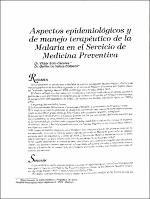| dc.contributor.author | Soto Cáceres, Víctor | |
| dc.contributor.author | Valera Collazos, Guillermo | |
| dc.contributor.author | Instituto Peruano de Seguridad Social | |
| dc.date.accessioned | 2024-02-23T20:15:07Z | |
| dc.date.available | 2024-02-23T20:15:07Z | |
| dc.date.issued | 1993-06 | |
| dc.identifier.citation | Revista Médica del IPSS. 1993; 2(1-2). | es_PE |
| dc.identifier.uri | https://hdl.handle.net/20.500.12959/4924 | |
| dc.description.abstract | Se ha efectuado un estudio con la finalidad de exponer los aspectos epidemiológicos, clínicos y de manejo terapéutico de la malaria registrada en el servicio de Medicina Preventiva del Hospital Nacional "Almanzor Aguinaga Asenjo" IPSS. de Chiclayo entre los años 1986 a 1991.
El diseño utilizado fue descriptivo con revisión de la casuística notificada en el servicio durante el quinquenio y con seguimiento de cumplimiento de casos en el Programa del Ministerio para verificar el cumplimiento del tratamiento en 1988 y de registros del Servicio para dicho efecto en 1989 y 1991.
Los principales resultados fueron:
1) Se han presentado 224 casos en el quinquenio 1986-1991 a un promedio de 37 casos anuales. 2) La mayoría de casos se presentan en el segundo trimestre del año, aunque la notificación es permanente; la mayoría en grupo etáreo de 30 a 44 años y de ocupación magisterio o empleado.
3) Los Servicios de Emergencia y Consulta Externa son los que remiten principalmente los casos que son manejados en su mayoría en forma ambulatoria.
4) La sintomatología predominante comprende fiebre, escalofríos y sudoración, aunque la presencia de vómitos, diarrea y lumbalgia puede ocasionar confusiones diagnósticas con otros cuadros infecciosos digestivos o renales.
5) El manejo terapéutico dispuesto por el Ministerio durante varios años en dos etapas se confirmó no era adecuado, pues sólo el 45% de casos cumplían con acudir al Ministerio para recibir su segunda parte de dosis de tratamiento; a partir de 1989 el Servicio de Medicina Preventiva asume el tratamiento completo y se logra cobertura del 75% de cumplimiento, de la terapia radical.
6) Se sugiere implementar el sistema de visita domiciliaria para confirmar cumplimiento de terapia, ubicar a los descontinuadores; asimismo el reforzamiento del sistema educativo e informativo sobre la malaria y la necesidad de cumplir todo el tratamiento para evitar recaídas, cronicidad y sobre todo reservorio permanente. | es_PE |
| dc.description.abstract | It was realized an study with the purpose to expose the epidemiological, clinical and therapeutical use sights of malaria controlled by the Preventive Medicine Service of the National Hospital AImanzor Aguinaga Asenjo - IPSS - Chiclayo, between 1986 to 1991. The design used was descriptive with a revision of the casuistry, notified at the Service during the quinquennium and with a following accomplishment of cases at the Ministry Program to verify the performance of the treatment in 1988 and of the registers of the Service for that effect in 1989 and 1991.
The principal results were:
1.-224 cases were presented in the quinquennium 1986-1991 with an average of 37 yearly cases. 2.- The majority of cases were presented at the second quarter of the year, though the notification is permanent; the majority in 30 to 44 years old, mastery occupation or employee.
3.- The Emergency Services and Extern Consult were the ones who principally send the cases majority done in ambulatory form.
4.- The predominant symptomatology includes fever, chill and sweatiness, tough the presence of vomiting, diarrea and lumbar pain can cause diagnostic disorders with other digestive or renal infectious square.
5.- The therapeutic management disposed by the Ministry during many years in two stages were confirmed not adequate because only 45% of cases execute to assist to the Ministry to receive their second part of treatment dose; since 1989 the Preventive Medicine Service assumes the complete treatment and obtain a cover of 75%) of accomplishment, of radical therapy.
6.- Its suggest to implement the domiciliary visit system to confirm the therapy accomplishment, situate the discontinuators; also the strengthening of the educative and the informative system about malaria and the necessity of perform all the treatment to avoid the backsets, chronicity and permanent reserve. | es_PE |
| dc.format | application/pdf | es_PE |
| dc.language.iso | spa | es_PE |
| dc.publisher | Seguro Social de Salud (EsSalud) | es_PE |
| dc.rights | info:eu-repo/semantics/openAccess | es_PE |
| dc.rights.uri | https://creativecommons.org/licenses/by-nc-sa/4.0/ | es_PE |
| dc.subject | Métodos epidemiológicos | es_PE |
| dc.subject | Malaria | es_PE |
| dc.subject | Epidemiología | es_PE |
| dc.subject | Medicina preventiva | es_PE |
| dc.subject | Control de enfermedades transmisibles | es_PE |
| dc.title | Aspectos epidemiológicos y de manejo terapéutico de la Malaria en el Servicio de Medicina Preventiva | es_PE |
| dc.type | info:eu-repo/semantics/article | es_PE |
| dc.subject.ocde | https://purl.org/pe-repo/ocde/ford#3.02.29 | es_PE |
| dc.subject.ocde | https://purl.org/pe-repo/ocde/ford#3.03.08 | es_PE |






